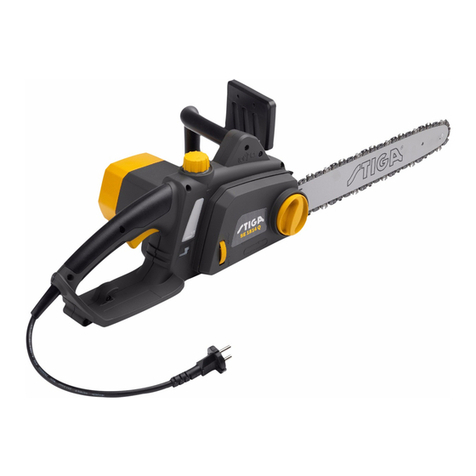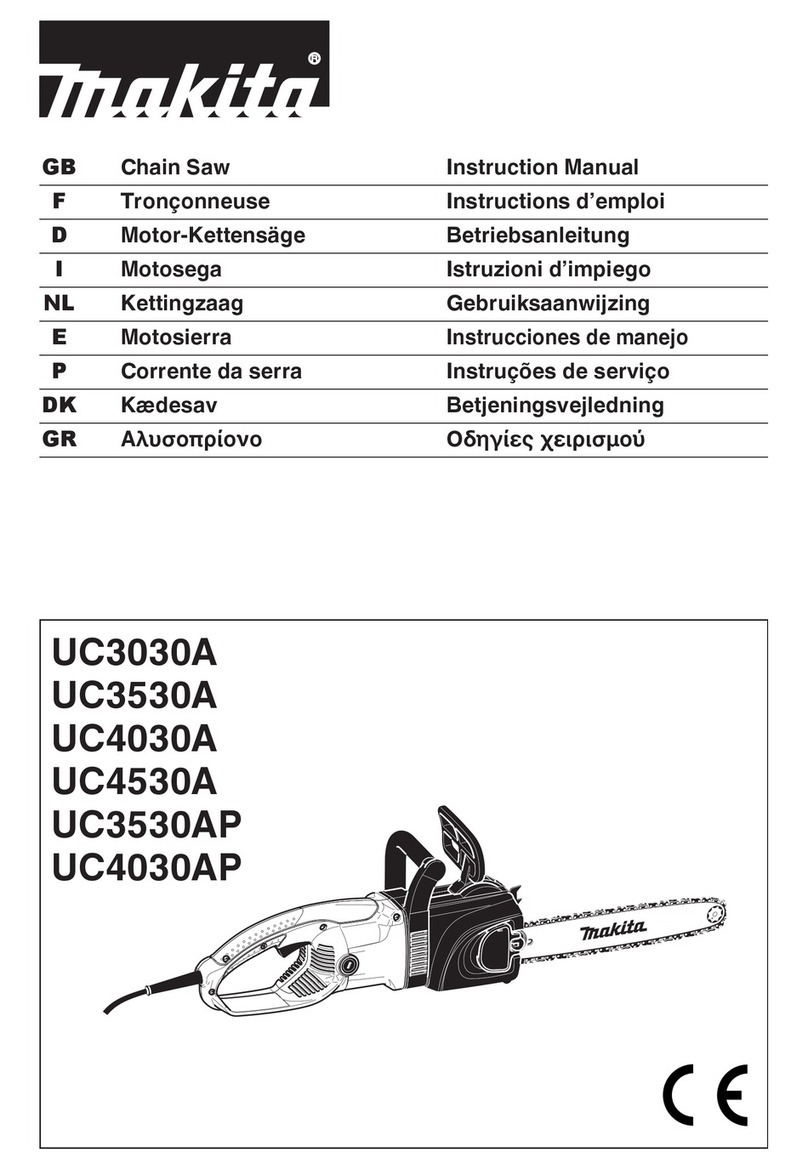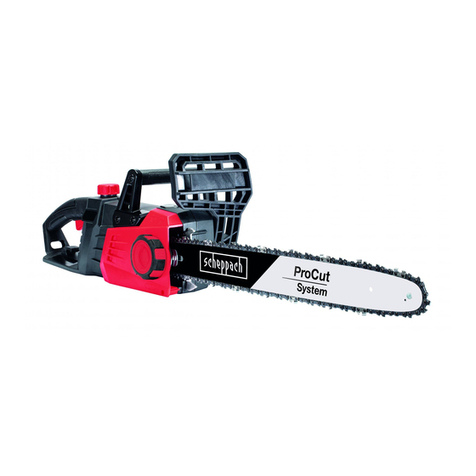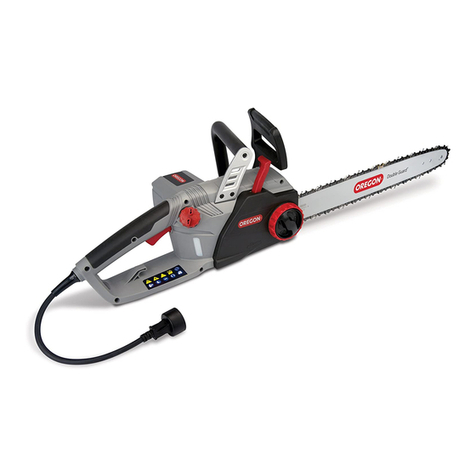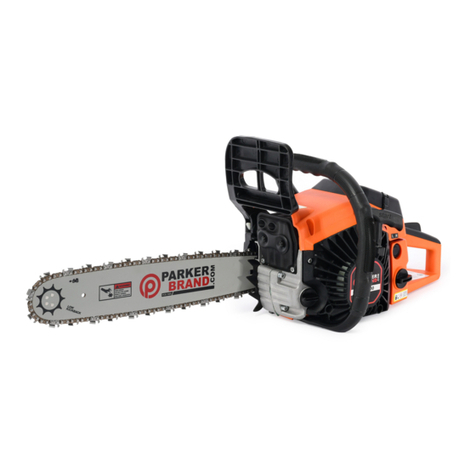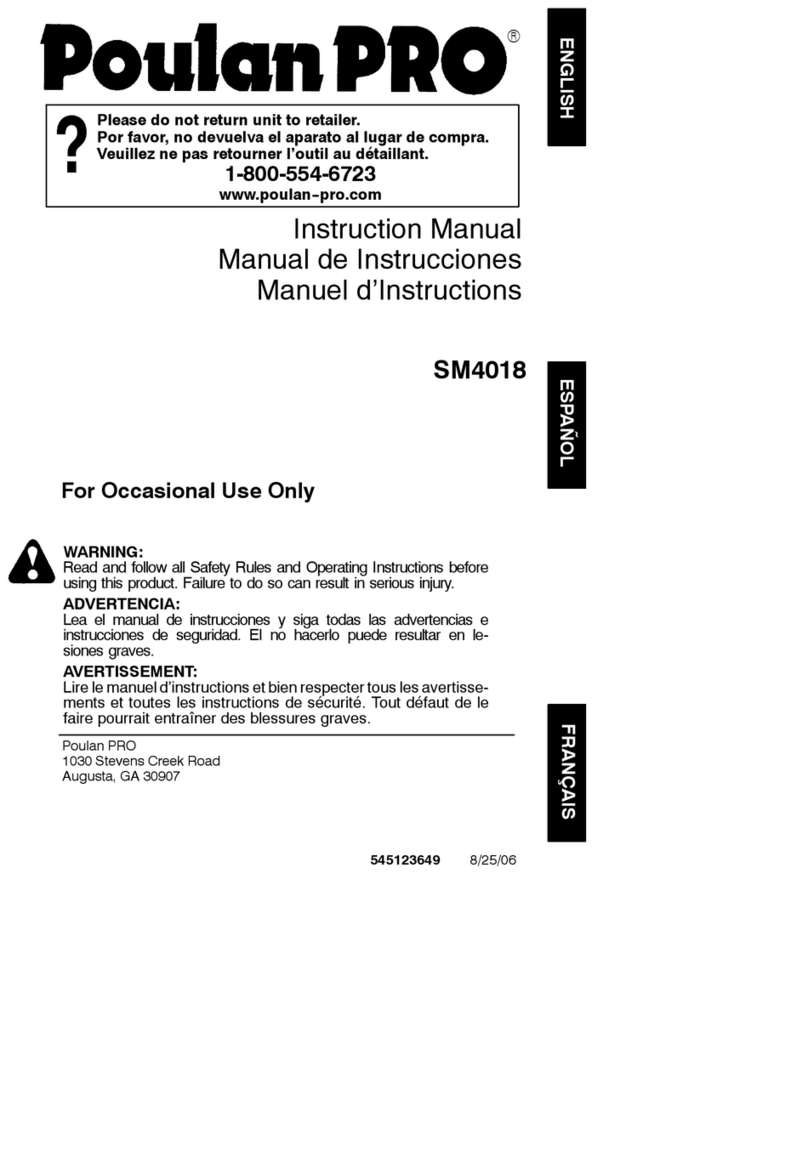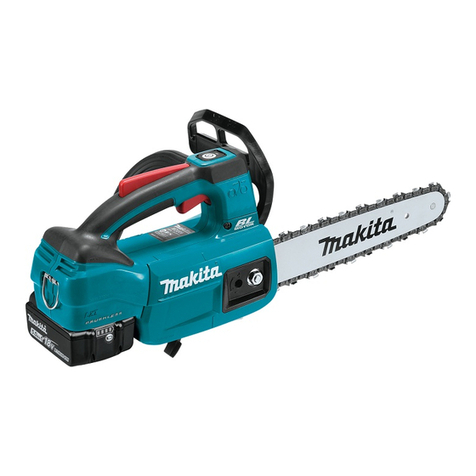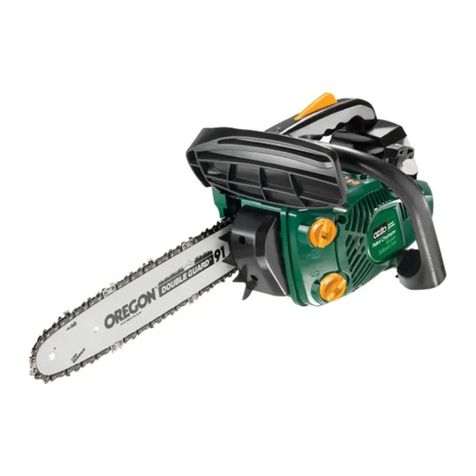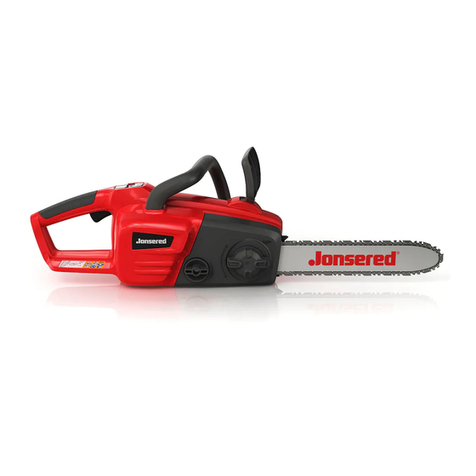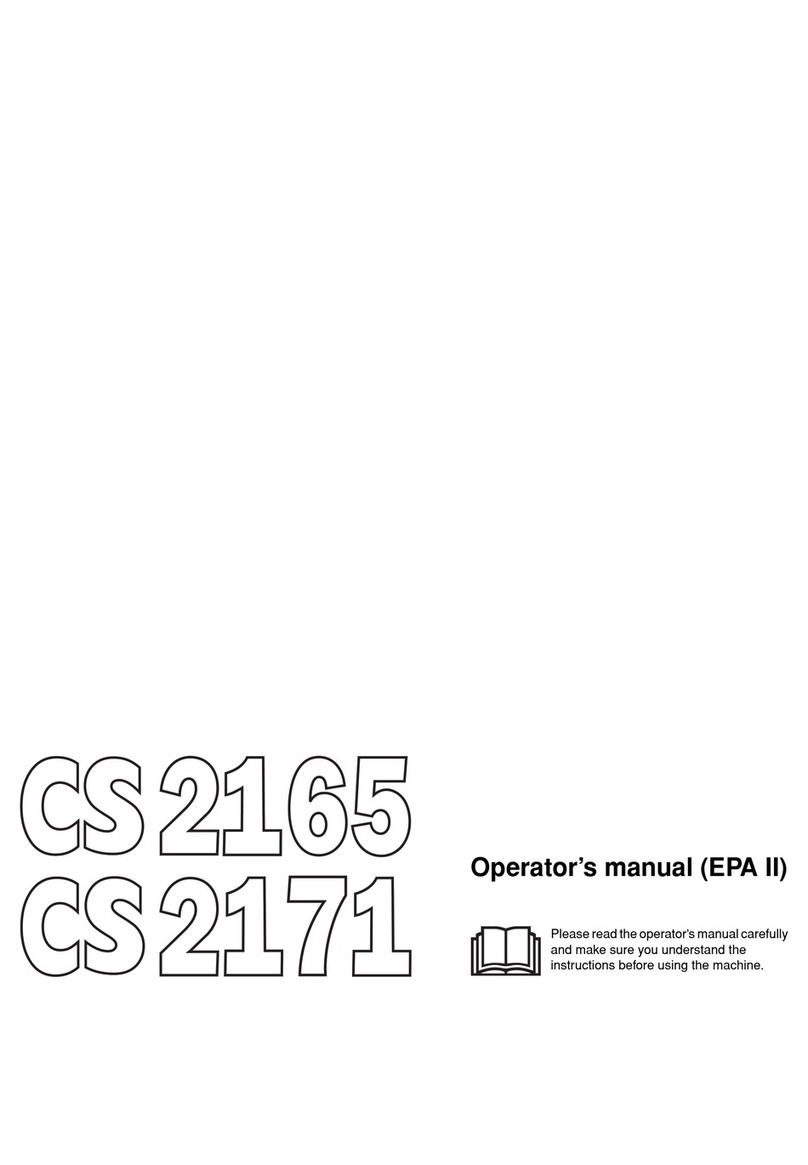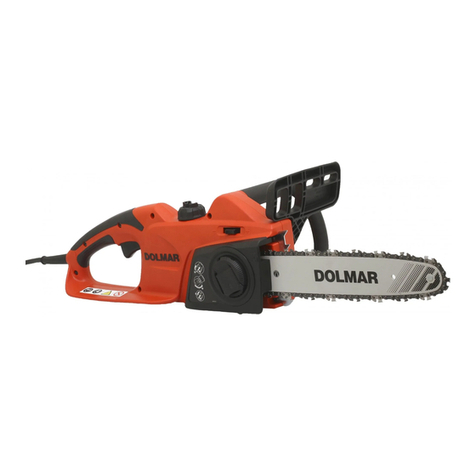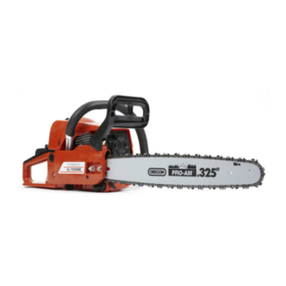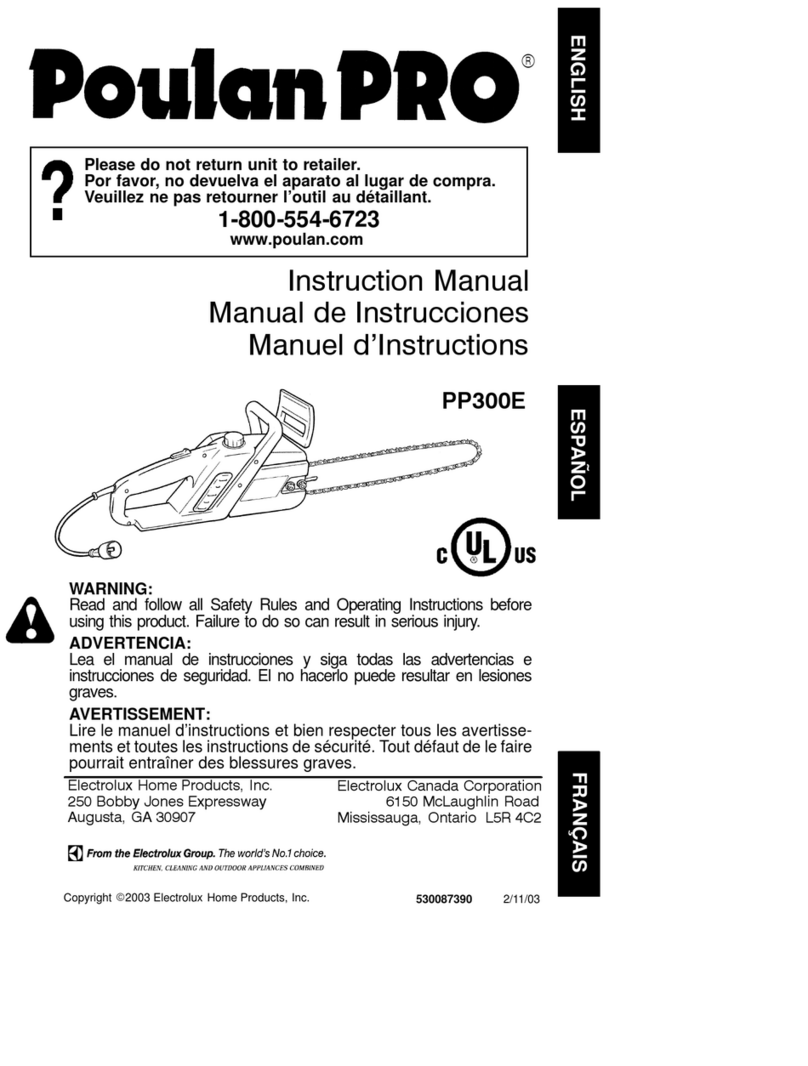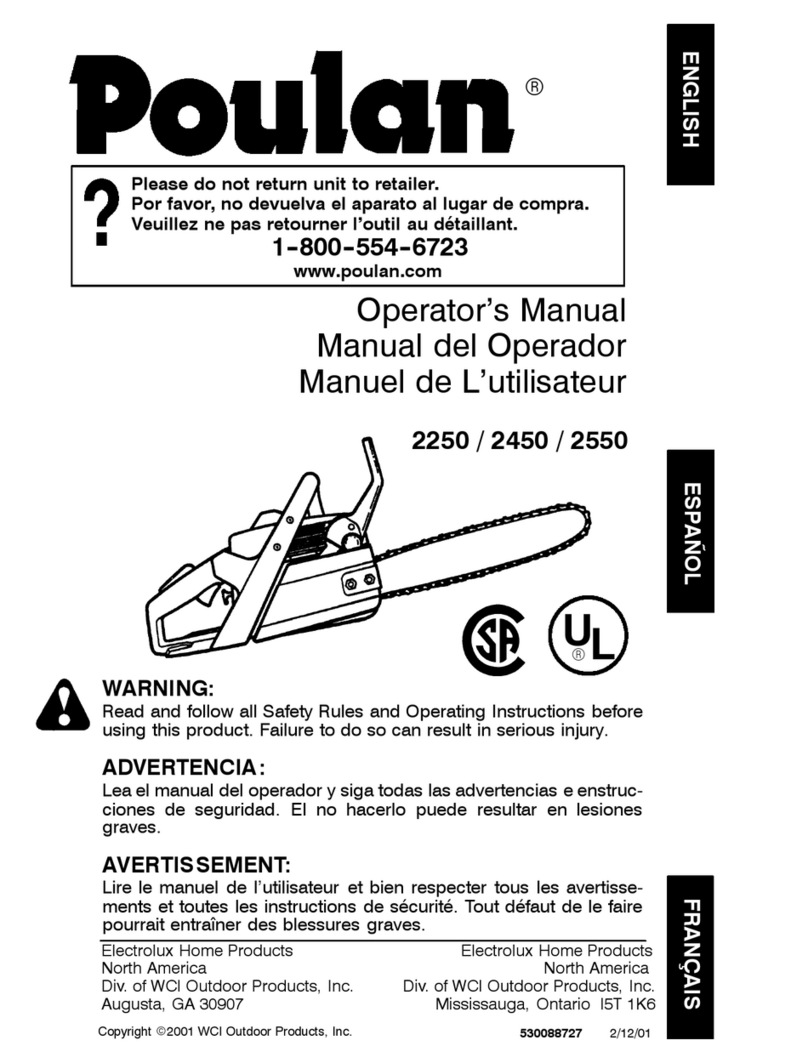TimberKing TKA 015A User manual

PNEUMATIC CHAINSAW
OPERATING MANUAL
Models
TKA 015A, TKA 017A, TKA 021A, TKA 025A,
TKA 015Z, TKA 017Z, TKA 021Z and TKA 025Z
(A = Aluminium, Z = Zinc)

TIMBERKING Pneumatic Chainsaw Operating Manual V3 | 20.04.15
2
WARNING!
IT IS VERY IMPORTANT THAT YOU READ THIS
MANUAL BEFORE OPERATING YOUR CHAINSAW
CHAINSAWS CAN BE DANGEROUS
Each year many people are injured in chainsaw
accidents. Most of these accidents can be avoided. The
hands, knees, feet and head are most vulnerable to
being cut by the saw chain.
If you use a chainsaw often, there are also other health
risks. The continual noise of the chainsaw can lead to
permanent hearing loss and vibration can cause
permanent damage to the hands.
These hazards mean that chainsaws are potentially one
of the most dangerous pieces of industrial equipment if
not used correctly.
With the use of the correct protective clothing, and
proper work practices, this equipment can be used
safely.
In the next few pages you’ll read valuable information
concerning safe chainsaw operation. There is a checklist
of the safety instructions. Tips on the protective clothing
you should wear, and suggestions for safe work methods
are provided. Please read on!

TIMBERKING Pneumatic Chainsaw Operating Manual V3 | 20.04.15
3
GENERAL SAFETY PRECAUTIONS
This owner’s manual will tell you the safety features of your
chainsaw and the correct way of operating it.
Check your chainsaw thoroughly before use. Make sure your
bar, chain and sprocket are in top condition and that all safety
devices are working properly.
Regularly service your chainsaw.
Always wear protective clothing. Gloves, safety helmet with
visor or goggles, earmuffs, protective leggings and safety
boots should be worn at all times whilst operating your
chainsaw.
Do not start cutting until you have a clear work area, secure
footing and a planned retreat path from the operating area.
Keep other people and animals well away from the working
area.
Make sure there is a second person within calling distance.
Do not operate a chainsaw that is beyond your ability.
Use the chainsaw only to cut the correct material with the
correct chain.
Do not become distracted. Stop the chainsaw if somebody
starts speaking to you.
If you are tired, rest! Chainsaw operation requires maximum
and constant concentration. Tired operators can have
accidents.
PERSONAL SAFETY EQUIPMENT
Gloves, safety helmet with visor or goggles, earmuffs, protective
leggings and safety boots should be worn at all times whilst
operating your chainsaw to protect you from chain saw injury.

TIMBERKING Pneumatic Chainsaw Operating Manual V3 | 20.04.15
4
PREVENTING KICKBACK
Kickback is a sudden upward and backward movement of the
saw. It occurs when the tip of the bar nose contacts a log,
branch or nail. It can cause serious injury.
FIGURE 1
TO PREVENT INJURY FROM KICKBACK
Ensure your chain saw is fitted with a chain protector safety bar
and a bumper spike.
Use low kickback chain types and avoid lowering the depth
gauges too much when sharpening.
Hold the chainsaw firmly making sure that the left hand
encircles the top handle with the thumb underneath.
Avoid bringing the upper quadrant of the guide bar into
contact with any foreign object.
Wear correct head protection and safety pants at all times.
Avoid cutting above your shoulder height.
Never hold the chainsaw in one hand.
Always begin at peak (rev’s) power.

TIMBERKING Pneumatic Chainsaw Operating Manual V3 | 20.04.15
5
PREVENTING RAYNAUD’S DISEASE AND OCCUPATIONAL OVERUSE
SYNDROME
The vibration from chainsaws can cause damage to the hands if
used for long periods of time.
Use the chainsaw with ergonomically angled handles. These
greatly reduce uneven and undue pressure on the hands.
Take regular rest breaks from continuous operations.
Wear gloves.
Sharpen your chain regularly. This will ensure smoother cutting
and less vibration.
MAINTAINING YOUR CHAINSAW
A chainsaw is designed to meet various safety requirements. Use
the diagrams to check and understand the safety features, even
if they may be optional extras when you buy it.
Never operate a chainsaw that is damaged, not properly
adjusted or wrongly assembled. Your chainsaw requires regular
maintenance.
IMPORTANT!
If your chainsaw is used underwater, the motor must be flushed
immediately after use with preservatives such as Valvoline Tectyl
930.
BEFORE YOU START WORK, CHECK THAT…
1. The machine is in good condition (no leaks, wear or damage).
2. The throttle trigger and safety throttle lock operate correctly.
3. The chain is lubricated, sharp and tension is correct.
4. The air pressure is correct. Maximum 7 bar –do not exceed!

TIMBERKING Pneumatic Chainsaw Operating Manual V3 | 20.04.15
6
AFTER FINISHING YOUR WORK, OR DAILY…
1. Clean the chainsaw, particularly the sprocket guard.
2. Check the chainsaw thoroughly from top to bottom, see that it
is lubricating properly.
REGULARLY…
1. Sharpen your saw chain.
2. Check the guide bar for burring.
3. Check the sprocket for wear. It can clog up with oil and dirt
and may malfunction.
4. Have your chainsaw serviced regularly.
PREVENTING NOISE INDUCED HEARING LOSS
Most chainsaws emit noise levels that can cause permanent
damage to your hearing if used for long periods at a time.
Always use safety standards approved earmuffs or plugs.
Ensure your chainsaw is tuned to manufacturers specifications.
PREVENTING FIRES
1. Don’t smoke while operating the chainsaw.
2. Keep a fire extinguisher, spray pump and shovel nearby.

TIMBERKING Pneumatic Chainsaw Operating Manual V3 | 20.04.15
7
TRAINING AND SUPERVISION
Chainsaw operators should be properly trained. Training may be
on-the-job or through a recognised training course. Training
should include instructions on:
Safe working techniques.
Operating conditions, including unusual or dangerous
conditions.
Basic information about the chainsaw and its controls,
attachments and components, design capacity, stability and
limitations.
Correct stopping and starting techniques.
Cleaning and servicing.
Being alert for the possibility of kickback.
Chain sharpening techniques.
Less experienced operators should be carefully supervised.
Certain operations are extremely dangerous and should only be
undertaken by professionals. These include the removal of
branches from standing trees, the removal of trees hung up in
wires, cutting trees thicker than the guide bar length, and working
in windblown and foul weather areas.

TIMBERKING Pneumatic Chainsaw Operating Manual V3 | 20.04.15
8
A REVIEW OF SAFETY PROCEDURES
Operator should wear dress of close fitting style, safety boots
and leather gloves.
When carrying the chainsaw about, the chain should be fitted
with a chain guard.
Chainsaws should never be run without oil.
Always hold the saw with both hands and keep a firm stance
when working with the chainsaw.
No other person should stand within the working radius of the
saw.
Before you start cutting, press the spike bar against the
material being cut.
When cutting splintered wood, take precaution. Large splinters
can fly towards the operator.
Only use the underside of the bar when cutting at shoulder
height. T
he pressure hose should be closed when the chainsaw is set
aside even for a short while or when the chain tension is tested
or adjusted.
The operator should always work calmly and cautiously and
should also avoid any danger to themselves or other persons.

TIMBERKING Pneumatic Chainsaw Operating Manual V3 | 20.04.15
9
ASSEMBLING THE GUIDE BAR AND CHAIN
Direction of the chain travel (L), the cutting edges of the chipper
chain on the top edge of the guide bar must face in the direction
of the guide bar nose. Put the pivot of the square nut for chain
tensioning into the tap-hole in the guide bar. Assemble the
sprocket guard and screw the nut finger tight.
FIGURE 2

TIMBERKING Pneumatic Chainsaw Operating Manual V3 | 20.04.15
10
TIGHTENING THE CHAIN
Turn the tensioning screw clockwise. The nose of the guide bar
should be lifted slightly. The chain should not sag but should be
easily moved by hand (wear gloves) alongside the guide bar.
Tighten sprocket guard nut. A newly fitted chain should be
allowed to rotate for 5 minutes with good lubrication and then
re-tighten the chain.
FIGURE 3
FIGURE 4

TIMBERKING Pneumatic Chainsaw Operating Manual V3 | 20.04.15
11
FILLING OF SAW CHAIN OIL
Figure 4B –PLEASE: Never use old oil!
Tank cap CHAIN OIL (A): Special non-drip chain oil, otherwise use
regular grade SAE 30 engine oil. Tank capacity is 0.49 Litres.
FIGURE 4B

TIMBERKING Pneumatic Chainsaw Operating Manual V3 | 20.04.15
12
CONNECTION OF COMPRESSED AIR
Inside thread in rear handle ¾” B.S.P. For reasons of safety it
should be easy to switch off the compressed air within reach of
the working place. Blow out pressure hose before connecting.
System pressure 85 to 100 p.s.i (6 to 7 bar).
MOUNTING A NEW CHAIN
1. Loosen mounting bolt.
FIGURE 5
2. Tighten chain tension adjustment screw until the coupling links
touch the bar. Lift bar nose slightly whilst adjusting tension.
FIGURE 6

TIMBERKING Pneumatic Chainsaw Operating Manual V3 | 20.04.15
13
3. Pull chain around by hand.
FIGURE 7
4. Lift bar and tighten mounting bolt.
FIGURE 8
AFTER MOUNTING A NEW CHAIN
1. Allow chainsaw to run for a short period of time at low speed
while applying a liberal amount of oil to the chain.
2. Turn off motor and re-adjust chain tension. Re-start saw and
make a few light cuts. Re-adjust chain again if necessary. It is
important to monitor chain tension during the first half-hour of
operation.

TIMBERKING Pneumatic Chainsaw Operating Manual V3 | 20.04.15
14
OPERATING INSTRUCTIONS FOR PNEUMATIC CHAIN SAW
CHAIN CARE (Figure 9)
The illustrations shown in figure 9 clearly show the difference. The
second chain received excellent care. It still cuts, even though
the cutting teeth have been filed almost completely back. The
top chain is no longer serviceable, even though it was hardly
used.
FIGURE 9

TIMBERKING Pneumatic Chainsaw Operating Manual V3 | 20.04.15
15
Observe the following rules to obtain the best performance from
your chain:
1. Inspect the bar before mounting a new chain. Never run a
new chain on a worn bar.
2. Make sure the chain tension is correct. Do not run your
chainsaw with a chain that is too loose.
3. Sharpen your chain correctly. Follow the sharpening
instructions shown in figures 10 through to 12.
4. Always use plenty of oil when cutting. Oil is cheaper than a
new chain.
5. Keep the oil hole in the bar and the bar mount clean. Clean
these two points at least once a day.
6. When cutting frozen wood, mix approximately 25% diesel fuel
or kerosene with the chain oil.

TIMBERKING Pneumatic Chainsaw Operating Manual V3 | 20.04.15
16
CHAIN SHARPENING
(Figure 10)
Use chainsaw file with 5.5mm (7/32”) diameter for 0.404” pitch
chain. It is better to file at frequent intervals. File horizontally and
in the correct top plate angle (35 degrees), filing stroke should go
always from inside to outside. All cutters have to be precisely the
same length and height. Use chain gauge for inspection.
FIGURE 10

TIMBERKING Pneumatic Chainsaw Operating Manual V3 | 20.04.15
17
TIMBERKING Pneumatic Chainsaw Exploded View

TIMBERKING Pneumatic Chainsaw Operating Manual V3 | 20.04.15
18
TIMBERKING Pneumatic Chainsaw Parts List
Item
Number
Part
Number
Description
Quantity
Required
per Unit
1
TKA 201
Motor Housing Complete (Items 1-16)
1
1Z
TKA 201Z
Motor Housing Complete Zinc (Items 1-16)
1
2
TKA 202
Screw Fillister Head M6 x 65
1
3
TKA 203
Wave Washer 5.5
4
3A
TKA 203A
Spring Washer M6
5
3B
TKA 203B
Flat Washer M6
2
4
TKA 204
Chain Stretcher Complete (Items 2-5)
1
5
TKA 205
Hex Plain Nut M6
2
6
TKA 206
Guide Rail
1
6A
TKA 206A
Guide Rail Pin 3x26
2
7
TKA 207
Stud
1
8
TKA 208
Wave Washer M10
2
9
TKA 209
Hex Nyloc Nut M10
1
10
TKA 210
Hex Plain Nut M10x1
1
11
TKA 211
Seloc Pin 5 x 16
2
12
TKA 212
Capscrew 5.5 M8 x 35
4
13
TKA 213
Wave Washer M8
4
14
TKA 215A
Brass Tube
1
15
TKA 215
Grub Screw
1
16
TKA 216
Gasket
1
17
TKA 217
Handle Complete (Items 17-26)
1
17Z
TKA 217Z
Handle Complete Zinc (Items 17-26)
1
18
TKA 218
Valve Ball
1
19
TKA 219
Pressure Spring
1
20
TKA 220
Spring Retainer (Spacer and Circlip)
1
21
TKA 221
Throttle Valve
1
22
TKA 222
Seloc Pin 5 x 26
2
23
TKA 223
Throttle Lever
1
24
TKA 224
Pressure Spring
1
25
TKA 225
Safety Lever
1
26
TKA 226
Pressure Spring
1
28
TKA 228
Screw, Cap, Socket Head
4
30
TKA 230
Gasket
2
31
TKA 231
Coupling (Customer Specifies Type)
Optional

TIMBERKING Pneumatic Chainsaw Operating Manual V3 | 20.04.15
19
Item
Number
Part
Number
Description
Quantity
Required
per Unit
32
TKA 232
Nipple Steel
Optional
33
TKA 233
Oil Tank Cover
1
33Z
TKA 233Z
Oil Tank Cover Zinc
1
35
TKA 235
Pressure Fitting
1
36
TKA 236
Meter Valve Complete (Items 36 + 43)
1
38
TKA 238
Pressure Line
1
39
TKA 239
Fillister Head Screw M6 x 25
3
41
TKA 241
Screw Plug, Oil Filter
1
42
TKA 242
'O' Ring
1
43
TKA 243
Suction Line
1
44
TKA 244
Silencer Complete (Items 44, 44A + 44B)
1
44A
TKA 244A
Silencer Filter
1
44B
TKA 244B
Silencer Gasket
1
45
TKA 245
Screw, Cap, Socket Head M5 x 12
4
47
TKA 247
Tubular Handle Complete (Items 47 + 48)
1
48
TKA 248
Protection Tube Grip
1
49
TKA 249
Stiffening Plate
1
50
TKA 250
Spring Washer M8
2
51
TKA 251
Hex Screw M8x40
1
52
TKA 252
Sprocket Guard
1
52Z
TKA 252Z
Sprocket Guard Zinc
1
53
TKA 253
Spike Bar
1
55
TKA 255
Hex Screw, Spike Bar Only M6 x 16
2
55A
TKA 255A
Hex Screw, Chain Guard, Spike Bar
Optional
56
TKB 356
Motor Complete (Items 57 - 68)
1
57
TKB 357
Cylinder Liner
1
58
TKB 358
Rotor
1
59
TKB 359
Vane
6
60
TKB 360
Back Bearing Disk
1
61
TKB 361
Front Bearing Disk
1
62
TKB 362
Bearing Front
1
63
TKB 363
Cylindrical Pin
1
64
TKB 364
Key
1
65
TKB 365
Spacer
1
66
TKB 366
Bearing Back
1
67
TKB 367
Notched Locking Nut
1

TIMBERKING Pneumatic Chainsaw Operating Manual V3 | 20.04.15
20
Item
Number
Part
Number
Description
Quantity
Required
per Unit
68
TKB 368
Hex Retaining Nut
1
69
TKB 369
Pressure Ring
1
70
TKB 370
Distance Ring
1
71
TKB 371
Spacer
1
72
TKB 372
Stop Disk
1
73
TKB 373
Chain Drive Sprocket
1
74
TKB 374
Stop Disk
1
75
TKB 375
(Use TKA 250)
Obsolete
76
TKB 376
Hex Screw M8x30
1
77A
TKC 380
15" Guide Bar
Optional
77B
TKC 430
17" Guide Bar
1
77C
TKC 530
21" Guide Bar
Optional
77D
TKC 630
25" Guide Bar
Optional
78A
TKC 055
15" Semi-Chisel Chain Loop
Optional
78B
TKC 061
17" Semi-Chisel Chain Loop
1
78C
TKC 070
21" Semi-Chisel Chain Loop
Optional
78D
TKC 078
25" Semi-Chisel Chain Loop
Optional
79A
TKC 155
15" Tungsten Carbide Chain (Wood)
Optional
79B
TKC 161
17" Tungsten Carbide Chain (Wood)
Optional
79C
TKC 170
21" Tungsten Carbide Chain (Wood)
Optional
79D
TKC 178
25" Tungsten Carbide Chain (Wood)
Optional
79E
TKC 255
15" Tungsten Carbide Chain (Soft Stone)
Optional
79F
TKC 261
17" Tungsten Carbide Chain (Soft Stone)
Optional
79G
TKC 270
21" Tungsten Carbide Chain (Soft Stone)
Optional
79H
TKC 278
25" Tungsten Carbide Chain (Soft Stone)
Optional
80
TKC 480
Solid Safety Chain Guard
Obsolete
81
TKC 481
Hinged Safety Chain Guard
Optional
81Z
TKC 481Z
Hinged Safety Chain Guard Zinc
Optional
81A
TKC 481A
Pigtail Spring
Optional
81B
TKC 481B
Post, Spring, Nut Only
Optional
83
TKC 483
Bar Nose Guard, SAF-T-TIP
Optional
84
TKC 484
Combination Screw Driver Wrench
1
84A
TKC 484A
Allan Key M6
1
85
TKC 485
Front Hand Guard
Optional
86
TKC 486
Underwater Kit
Optional
This manual suits for next models
7
Table of contents
